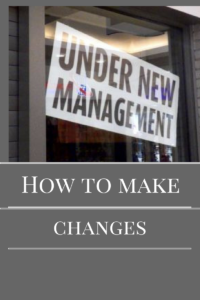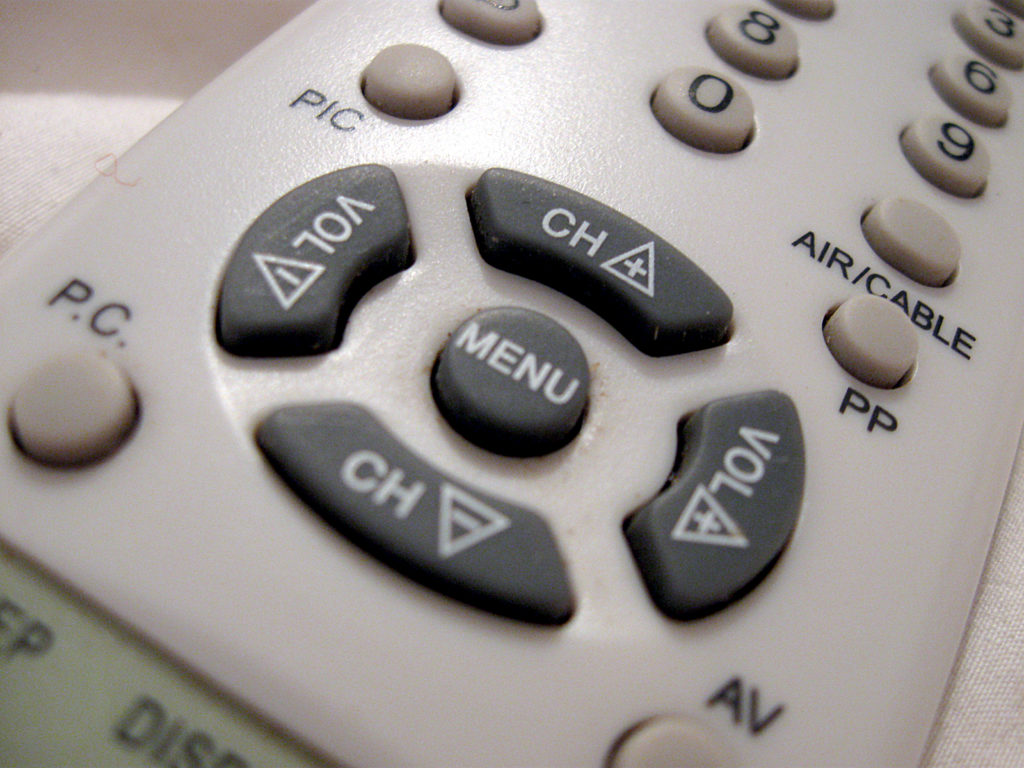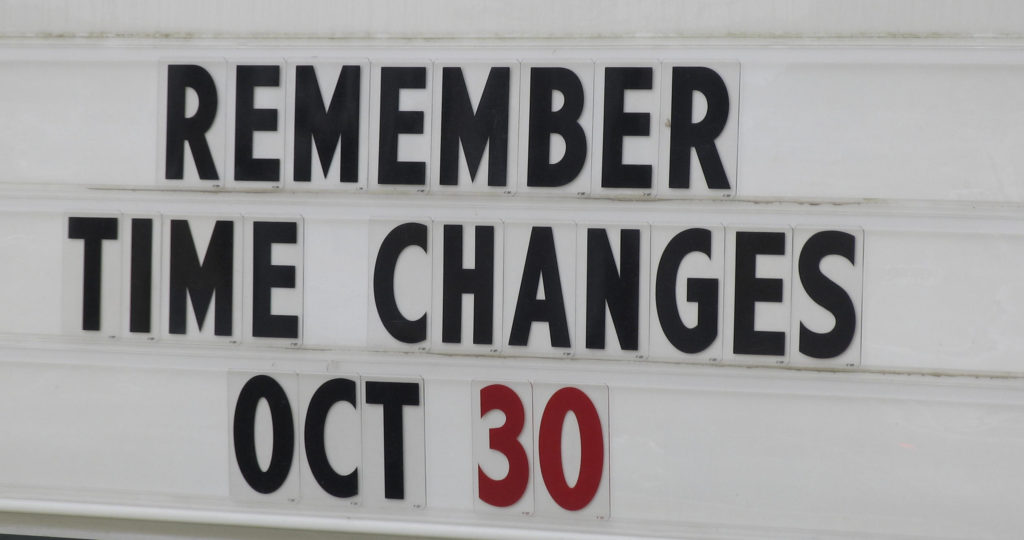How to make changes
Here we go again. We’re facing the same dilemmas we faced last month. Every month it’s the same… We
promise ourselves that things will be different next month, but they’re not. We need to learn how to make changes.
Maybe we vowed to stay on budget. Maybe we promised to save some money, or maybe we swore we’d lose weight. As usual, it didn’t happen. What can we do about it???
Insanity has been described as doing the same thing over and over again while expecting different results. If you think about it, that’s true, it is crazy. If we want different results, we have to change what we do.
Few people think the course of change all the way through. They don’t think of change as a process. Let’s face it everything we do, we do for a reason. Usually that reason is habit: Many times people look at their lives and say, “I need to start ______________,” or “I need to quit ________________.” (You fill in the blanks). But the need doesn’t inspire real action. Why?
It’s about how we’re thinking.
An example:
You decide to lose weight. The goal is to lose thirty pounds before summer. You want to be healthier (and look good at the beach).
You’ve done your research and found an eating plan that should work for you. You start off observing the guidelines of your diet—eating the types and quantities of food suggested. But, you’re (still) a foodie. You have a reason to lose weight, but you’re not thrilled with the process.
You haven’t changed your thinking about food.
If (more likely—when) you walk into a buffet, you’re going to admire all the food. (I could use a stronger verb than “admire.”) You’ll start thinking about how good it would taste. “Just one small serving—that’s all I’ll eat; I can burn the extra-calories later.” Yeah, right…
You haven’t changed the way you think about food or overeating. You are so ready to sabotage your plan. You’ll break your diet. (And it won’t be the only time.) You won’t lose the weight. Remorse may come later, but you’re happy in the “now.” The problem is not the food. The problem is how you regard your future and the role that food plays in getting
On the other hand:
On the other hand, there’s determination. (I’ve addressed determination before. See my post on http://startsavingmoneytoday.com/how-to-set-goals/setting goals.) If you’re determined be healthier by next summer, and believe that losing thirty pounds is a major factor in reaching that goal (Looking good at the beach is—really—just a nice by-product.), you will be very aware and determined to eliminate eating habits and foods that work against you.
Overeating is generally recognized as a bad habit. If you make weight loss a goal (or a step towards a goal), but have a tendency to overeat, you need to change this habit. Find or develop an eating program that allows you to lose weight and stick with it.
Of course, temptation plays a role. If you’re inclined to overeat, why go to a buffet in the first place? Eating a plated meal at a restaurant isn’t much better—because we’re inclined to eat “the whole thing.” At many restaurants the food in a single plated meal is equivalent of two or three servings. Do you have the will power to cut your meal in half, eat half now, and take the other half home for another meal—or maybe, just leave it on the plate. (Ouch! That last idea hurts my frugal sensibilities.)
Go a bit out of your way to avoid temptation. You don’t have to treat food as an enemy. After all, the food we eat goes a long way in determining our health. So, do some research: Learn about healthy eating and food preparation. And when you find a food plan that will help you meet your weight loss goal—Be Happy.
Ok … it’s unrealistic to think that you’ll cook and eat every meal at home. We all like to eat out once in a while, and for some it’s actually required. Research and planning can help you avoid dietary pitfalls when you dine out. Many restaurants post their menus online, and a variety of health agencies are promoting legislation that will require eating establishments to post caloric and (perhaps) other nutritional information in store and/or online. Also, you can compare the food you’d order to what you fix at home: If the 6 ounce steak you grill or broil at home has three to four hundred calories, you can be sure the one you order out has more. Also, look at the reviews. It’s likely someone has already found a place with healthy offerings—or issued a warning.
Here are a couple suggestions for eating out: Decide where you will eat and, if possible, what you will order before you head out. (I find this is easier if I have a limit of three restaurants I regularly patronize; three gives me variety without an overwhelming number of choices.) Go with a good friend (or spouse) who supports your effort to eat healthy; you can split a meal: Have and enjoyable time, and keep each other faithful to a good eating plan.
Sticking to that eating plan will contribute greatly to the success of your goal to lose weight, become healthier (and look good). The lack of such a plan implies a lack of discipline, and can be the reason someone struggles with weight and health issues. It’s best to prepare food and eat at home (or cook and carry it with you) most of the time. If you are buying foodstuff appropriate to your plan and eating in, a lot of foods detrimental to your effort won’t be within easy reach. Temptation can be avoided.
Of course, we can’t always avoid temptation. Here’s where determination comes in. You have to really want to reach your goal: Desire has to supersede need. When tempted, consider how much work it will take to undo the damage that giving in might cause.
When tempted, what do you do?
You change your mind. If you find yourself considering—dreaming—about less than optimal choices, purposefully think of something else. And why wait until you in a tough situation? Why not appreciate your new lifestyle. You are not really losing anything comparable to what you can gain—LIFE! As you prepare and eat your meals consider the scents, the textures, the colors, the taste… If possible, make prep and meal times companionable. Learn to enjoy and appreciate the new. Be convinced.
Your attitude makes a world of difference when it comes to making a change.
You ask, “How to make changes?” Work with both your mind and actions. You’ll change your habits. You’ll build a new reality.
Habits = what you do = what you are
I’m not a psychiatrist, but I understand enough about human nature to know that everything we do we do is done for a reason. Often the reason is “because that’s the way I’ve always done it,” or “I didn’t even think about it. I just did it.” This means it was done out of habit.
When you look at your life, and find habits you want to change, remember that you are not just going to do something different. Just doing something different tends to be temporary at best. You need to change the way you think about the issues. You’ll need to break old habits and make new ones. You’ll need to change you. Without determination—without a change of heart—it won’t happen.
Short story
Some time ago, I realized I had a limited vocabulary. I decided to increase it. I thought my best approach would be to dedicate some time to it everyday after I got home from work. I thought I’d sit down with a dictionary and search for an “inspiring” new word. After finding one, I’d write it down on a 3×5 card with the correct pronunciation and meaning. I’d carry the card around with me and from time to time look at it to refresh my memory.
That sounds plausible—right? What I didn’t take into account was my old habit.
Old habit
I was in the habit of grabbing a cup of coffee when I got home from work and—immediately—sitting down at the computer to work on my projects. So, my first attempt was…
A disaster
The first two days went well, but by the third day I wasn’t looking for a new word. I was right back into my old routine (habit). Building my vocabulary never even crossed my mind.
What happened?
By the third day I’d forgotten my goal. And that’s not surprising (See my post on how to set goals.): In truth, I’d done nothing more than wish my vocabulary was larger. I hadn’t changed my thinking, nor had I changed my habit. I hadn’t put together a real plan—certainly hadn’t bothered to write one down—and obviously was lacking determination. I mean, if I wasn’t willing to do something to keep my goal in mind, why could I assume I’d change the way I behaved?
Lessons learned
I realized (and not for the first time) how easy it is to lose sight of a goal—even a simple one.
I realized (again) that I needed to do something different, something that would help me keep my goal in mind and me on a track to reaching it.
I needed to think differently.
I’d already recognized the importance of increasing my vocabulary, and I’d already found the best time to devote to doing that. But how was I going to change the habits I had in place? When I hit the door, I was geared to grab a cup of coffee, sit down, and start working on a project. I needed to do something to interrupt my old habit and remind me of my new goal.
Solution
I decided to treat the goal of increasing my vocabulary seriously. I sat down at the computer and developed a fairly simple plan in a document. I set my goal as increasing my vocabulary by two words every day, Monday through Friday for a period of three months (with extensions possible). The steps to doing that were:
(1) Unplug the computer keyboard before I leave for work.
(2) Put a dictionary under the mouse.
(3) Put a sticky note on the computer screen reminding me to find and work on remembering two new words.
(4) Write them down on 3×5 cards with the correct pronunciation and meaning.
(5) Carry the cards around with me (at home and at work) and review them from time to time to refresh my memory.
(6) Post this plan on kitchen cabinet by the coffee maker.
Success
The second venture into increasing my vocabulary was a success. At the end of three months I had over to sixty new words I could use appropriately, and several times over the last few years I’ve repeated that success.
Now—when I want to work on increasing my vocabulary—it’s not hard to get into a habit that eases me into the learning process. When I get home I still get a cup of coffee, and the written plan is right there to remind me that I have something to do before I work on any other project. In order to use the computer I have to plug in the keyboard, move the dictionary so I can use the mouse, and pull the note on the screen (That note is a second reminder to do this thing.).
By the time I’ve done all those things (and yes, I know I could pull up an online dictionary, but in book form it’s another reinforcement) I’m ready to do the chore—if only so I can get on to other things. That said, it’s sometimes surprises me to find I really enjoy learning new words.
Oh, and the reason I post my plan by the coffee maker is that I take a cup with me on the way out. In case I haven’t already unplugged the keyboard, I can do it before I’m at the door; if it was posted on the door, I’d feel too far from my computer and, probably, wouldn’t go back to do it. So, the note gives support to my determination twice.
Because I’ve interrupted my usual routine and have designed a scenario that requires me to think about what I’m going to do, determination and action can work together for me to establish a new habit—one that gives me a greater opportunity to reach my goal.
Another example
I have a friend named Roxy. When I met Roxy, she was not into the every penny counts thing. She just wanted to save money (and she did—temporarily). But every time Roxy had a small stash, something would come up and she’d spend her savings.
Roxy’s old habit
Like most of us, Roxy’s pay is automatically deposited into her checking account. Every payday Roxy would go to her bank and transfer money from her checking account to her savings account. So far so good, but whenever anything out of the ordinary came up (and in the course of a week you can be sure something is going to come up), Roxy would withdraw from her savings the amount she needed to cover the event—and sometimes, a bit more. I’m sure you can guess the outcome: Something was always coming up, and Roxy’s savings account was always empty.
How often have we heard some version of Roxy’s story? Well … Roxy was tired of living it.
Roxy’s solution
Roxy opened an online savings account. She deliberately set the account up so she couldn’t receive any funds she requested in less than five working days. Regardless the nature of any event that came her way, she believed she could last five days without “extra” money.
Imposing a waiting period on herself made Roxy think about what she was doing with her money. She had to anticipate her financial needs on a weekly basis and keep sufficient funds accessible in her checking account. Since she could no longer just grab her debit card and make an instant withdrawal, when an unexpected financial opportunity (Think “challenge.”) came up, she had to consider (1) if it would still be in effect several days later, and (2) if she could resolve the situation by redirecting the use of her cash-on-hand. Also, since she had to order her money, she became less inclined to take out that “just a little extra”.
Roxy interrupted her pattern of behavior: She broke a couple of old habits.
Pattern interrupt
Roxy interrupted her behavior pattern (habit) by depositing the money in a savings account that would not release the funds to her in less than five working days. This triggered a change in how she thought about money. Roxy often decided that she would rather error on the side of caution and keep the money in her savings account; she came to believe she could last for five days without “extra” money. Most of the time, she was right.
When was the last time you needed money “right now” and tomorrow (or several tomorrows) would not be soon enough to have it? Usually, we can figure and finagle our way through—even if it is not always easy. Eventually, Roxy saw the value of a money plan, and she had…
One more benefit
Roxy developed a working budget with funds dedicated to long-term savings and an emergency fund as well as immediate and remote expenses. Budgeting became Roxy’s new habit and her “most of the time” from above evolved into a sure thing.
New habits replaced her old.
Conclusion
Our habits are what we do. They’re who we are and define where we are in life. If we want change, we have to change our habits. If we want to change our habits—either break old ones, or develop new ones—we have to do something that directs us towards our goal by interrupting our customary way of thinking and behaving.
The idea of a pattern interrupt is not new. And, it does work. The key is to set up a process that requires you to think about what you’re going to do next. This gives you the opportunity to evaluate your actions in regard to your goal: Thought and action have to work together.
It doesn’t have to be arduous.
We don’t need to constantly remind ourselves of our change in habit or of our goal. We need prompts at the appropriate time and place—when the old habit is likely to hijack our success. A pattern interrupt presents the time/space to make a choice. At that point you rely on your determination. (This is where having a written plan proves useful. It can bolster determination.)
Recognize that “today is a stepping stone to tomorrow.” What you do now can carry you toward the future you envision—or not. Think of your future—your goal—as being more real than your present. Act accordingly. This is how to make changes.
Never miss another post follow me on Facebook



